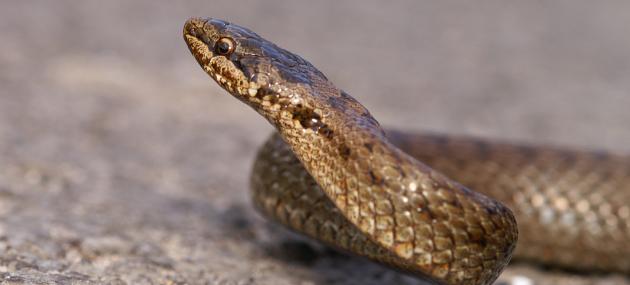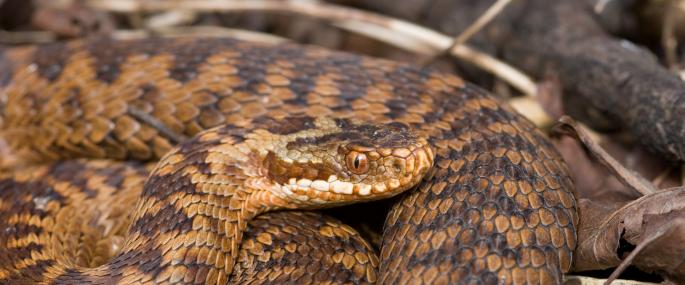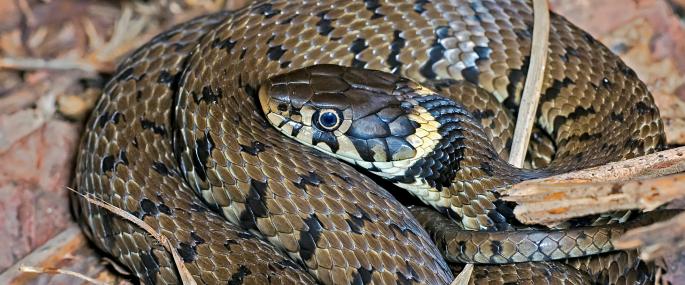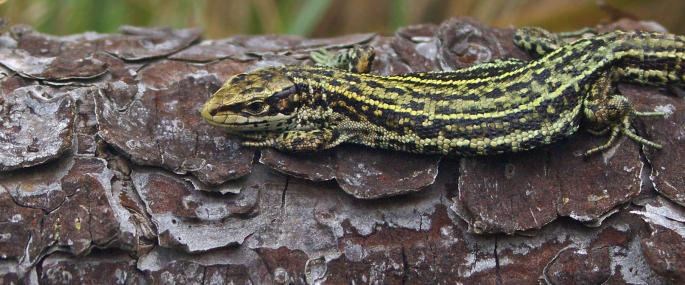Sand Lizard
Sand Lizards are one of the UK's rarest reptiles. They favour sandy heathland habitats and sand dunes and can be spotted basking on bare patches of sand. They also lay their eggs in the sand. Sand Lizards are confined to a few sites as destruction of their habitat has reduced their range.
Sand Lizards are extremely rare in Britain; they are mainly restricted to sandy heaths - a habitat suffering serious decline and under threat from human activity. Careful habitat management carried out by The Wildlife Trusts on local nature reserves where this creature lives helps it to survive; clearing scrub to allow heaths to flourish is vital if we are to protect our Sand Lizards. The Wildlife Trusts have also been involved with conservation projects to reintroduce the Sand Lizard to its former range. By volunteering for your local Trust you can help our work for this species and you'll make new friends and learn new skills along the way.
Smooth Snake
This rare snake can only be found in a few places, often alongside other rare reptiles like the sand lizard because they both favour the same kind of sandy heathland habitat. As with other reptiles, Smooth Snakes are cold-blooded so bask in the sun during the day and hibernate from October to April when they would struggle to warm up enough to be active.
Smooth Snakes are extremely rare in Britain; they are restricted to sandy and dry heaths - a habitat suffering serious decline and under threat from human activity. Careful habitat management carried out by The Wildlife Trusts on local nature reserves where this creature lives helps it to survive; clearing scrub to allow heaths to flourish is vital if we are to protect our Smooth Snakes. By volunteering for your local Trust you can help with this work and you'll make new friends and learn new skills along the way.

Adder
The Adder is a relatively small, stocky snake which prefers woodland, heathland and moorland. It hunts lizards and small mammals, as well as ground-nesting birds such as Skylark and Meadow Pipit. Adders hibernate from October, emerging in the first warm days of March, which is the easiest time of year to find them basking on a log or under a warm rock.
Adders were once quite common across heaths, grasslands and woods, but have suffered serious declines mainly due to the loss and fragmentation of their habitat as well as persecution. Careful habitat management carried out by The Wildlife Trusts on local nature reserves where this creature lives helps it to survive; opening up areas for it to sunbathe and providing basking sites constructed from logs are just some of the ways we're helping Adders. By volunteering for your local Trust you can help too, and you'll make new friends and learn new skills along the way.

Grass Snake
Our largest snake, the Grass Snake, particularly likes wetland habitats, but can also be found in dry grasslands and in gardens, especially those with a pond nearby.Lays eggs in rotting vegetation, often in compost heaps. Like all reptiles, Grass Snakes hibernate, usually from October to April. During the summer, they can be found basking near favourite ponds or even swimming.
The loss of our grassland and wetland habitats through human activity threatens the survival of our reptiles. The Wildlife Trusts are working closely with planners, developers and farmers to ensure these habitats are protected by fostering Living Landscape schemes: networks of habitats and wildlife corridors across town and country, which are good for both wildlife and people. You can help: look after grass snakes and other reptiles in your garden by leaving piles of logs for hibernating beneath. In partnership with the RHS, The Wildlife Trusts' Wild About Gardens initiative can help you plan your wildlife garden.

Slow-worm
Despite their name and appearance, slow-worms are neither worms nor snakes, but are in fact lizards - they're given away by their ability to shed their tails and blink with their eyelids. They can be found in heathland, tussocky grassland, woodland edges and rides: anywhere they can find invertebrates to eat and a sunny patch in which to sunbathe. They are often found in mature gardens and allotments, where they like hunting around the compost heap. However, if you have a cat, you are unlikely to find them in your garden as cats predate them.
The loss of our heathland and grassland habitats through human activity threatens the survival of our reptiles. The Wildlife Trusts are working closely with planners, developers and farmers to ensure these habitats are protected by fostering Living Landscape schemes: networks of habitats and wildlife corridors across town and country, which are good for both wildlife and people. You can help: look after slow-worms and other reptiles in your garden by leaving piles of logs for hibernating beneath. In partnership with the RHS, The Wildlife Trusts' Wild About Gardens initiative can help you plan your wildlife garden.
Common Lizard
The common lizard is the UK’s most common and widespread reptile. It is the only reptile native to Ireland. It is found across many habitats including heathland, moorland, woodland and grassland where it can be seen basking in sunny spots. Also known as the viviparous lizard, the species is unusual among reptiles for ‘giving birth’ to live young rather than laying eggs.
The loss of our heathland and grassland habitats through human activity threatens the survival of our reptiles. The Wildlife Trusts are working closely with planners, developers and farmers to ensure these habitats are protected by fostering Living Landscape schemes: networks of habitats and wildlife corridors across town and country, which are good for both wildlife and people. You can help: look after lizards and other reptiles in your garden by leaving piles of logs for hibernating beneath. In partnership with the RHS, The Wildlife Trusts' Wild About Gardens initiative can help you plan your wildlife garden.

Common Frog
Common Frogs are amphibians, coming to ponds to breed during the spring and spending much of the rest of the year feeding on dry land, in woodland, gardens, hedgerows and tussocky grassland. Frogs are a familiar inhabitant of garden ponds, where they lay their eggs in big clumps of spawn. They feed on a variety of invertebrates and smaller amphibians. Females are bigger than males.
Human activity, including the drainage of land for agriculture and the loss of ponds through development, has resulted in the disappearance of many wetlands. This has taken its toll on wetland wildlife like frogs The Wildlife Trusts are working closely with planners, developers and farmers to ensure our wetlands are protected. You can help: encourage frogs and other amphibians into your garden by having a wildlife-friendly pond and leaving piles of logs for hibernating beneath. In partnership with the RHS, The Wildlife Trusts' Wild About Gardens initiative can help you plan your wildlife garden.
Natterjack Toad
Smaller than the Common Toad, Natterjacks are very rare. They breed in warm, shallow pools in sand dunes and on sandy heaths in just a handful of special places. They are mainly nocturnal. In the spring, the males all sing together at night to attract females. Natterjacks are an endangered species, and protected under British law.
The loss of heathland and coastal habitats through human activity threatens the survival of this toad in the UK. The Wildlife Trusts are working closely with planners, developers and farmers to ensure these habitats are protected by fostering Living Landscape schemes: networks of habitats and wildlife corridors across town and country, which are good for both wildlife and people. You can support this greener future by joining your local Wildlife Trust.
Common Toad
Common Toads are amphibians, breeding in ponds during the spring and spending much of the rest of the year feeding on dry land in woodland, gardens, hedgerows and tussocky grassland. Common Toads breed in larger, deeper ponds than Common Frogs. They are famous for their mass migrations back to their breeding ponds on the first warm, damp evenings of the year, often around St. Valentine's Day.
Human activity, including the drainage of land for agriculture and the loss of ponds through development, has resulted in the disappearance of many wetlands. This has taken its toll on wetland wildlife like toads. The Wildlife Trusts are working closely with planners, developers and farmers to ensure our wetlands are protected. You can help: encourage toads and other amphibians into your garden by having a wildlife-friendly pond and leaving piles of logs for hibernating beneath. In partnership with the RHS, The Wildlife Trusts' Wild About Gardens initiative can help you plan your wildlife garden.
Palmate Newt
Newts are amphibians, breeding in ponds during the spring and spending most of the rest of the year feeding on invertebrates in woodland, hedgerows and tussocky grassland. They hibernate underground, amongst tree roots and in old walls. Palmate Newts are more likely to be found in ponds in upland areas and moorlands than other newt species.
Human activity, including the drainage of land for agriculture and the loss of ponds through development, has resulted in the disappearance of many wetlands. This has taken its toll on wetland wildlife like newts. The Wildlife Trusts are working closely with planners, developers and farmers to ensure our wetlands are protected. You can help: encourage Newts and other amphibians into your garden by having a wildlife-friendly pond and leaving piles of logs for hibernating beneath. In partnership with the RHS, The Wildlife Trusts' Wild About Gardens initiative can help you plan your wildlife garden.